 |
 |
 |
| |
TURQUOISE-I:
SAFETY AND EFFICACY OF ABT-450/R/OMBITASVIR, DASABUVIR, AND RIBAVIRIN IN PATIENTS CO-INFECTED WITH HEPATITIS C AND HIV-1
|
| |
| |
Reported by Jules Levin
20th International AIDS Conference, July 20-25, 2014, Melbourne
Mark S. Sulkowski, Joseph J. Eron, David Wyles, Roger Trinh, Jay Lalezari, Jihad Slim, Joseph Gathe, Peter J. Ruane, Chia Wang, Richard Elion, Fritz Bredeek, Robert Brennan, Gary Blick, Amit Khatri, Krystal Gibbons, Yiran B. Hu, Linda Fredrick, Tami Pilot-Matias, Barbara Da Silva-Tillmann, Barbara McGovern, Andrew L. Campbell, Thomas Podsadecki

Darunavir cohorts (Part 1b of the study) - For your reference only
Subjects on a stable QD darunavir (DRV)-containing HIV-1 ART regimen will be randomized to either maintain DRV QD or to switch to DRV BID administration during a pretreatment period. All subjects in Part 1b will then receive ABT-450/r/ABT-267 150/100/25 mg QD + ABT-333 250 mg BID + RBV for 12 weeks during the treatment period and be followed for 48 weeks after the end of treatment.
TURQUOISE-I, Part 2 - For your reference only
Study design is still being finalized. Will be conducted as a multicenter, international trial.
Will include an evaluation of the 3-DAA regimen without RBV in select sub-populations
Will include expanded study eligibility to allow inclusion of sub-populations prevalent amongst GT 1 HCV/HIV-1 coinfected persons traditionally excluded from clinical trials:
·Less well-documented response to prior treatment with pegIFN/RBV (e.g. Prior Relapse/Breakthrough, Prior Nonresponders)
·Failed a sofosbuvir-inclusive HCV treatment regimen
·Interferon-intolerant

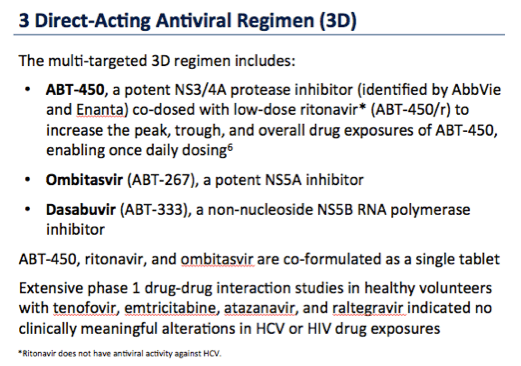
6Menon R, et al. HepDART 2009.
ABT-450: nanomolar potency in vitro. In treatment-naïve patients with HCV GT 1 infection, 3-day ABT-450/r monotherapy resulted in a mean maximum decrease from baseline in HCV RNA of 3.91 to 4.11 log10 IU/mL
Ombitasvir (ABT-267): pangenotypic picomolar potency in vitro. In treatment-naïve patients with HCV GT1 infection, 3-day ABT-267 monotherapy resulted in a mean HCV RNA decrease of 3.10 log10 IU/mL
Dasabuvir (ABT-333): nanomolar potency in vitro. In treatment-naïve patients with HCV GT1 infection, 3-day ABT-333 monotherapy resulted in a mean HCV RNA decrease of 1.00 log10 IU/mL
Ritonavir is dropped from the atazanavi-rinclusive ART regimen during the period of co-administration with the 3-DAA regimen. ATV is taken at the same time as the morning dose of ABT-450/r/Ombitasvir
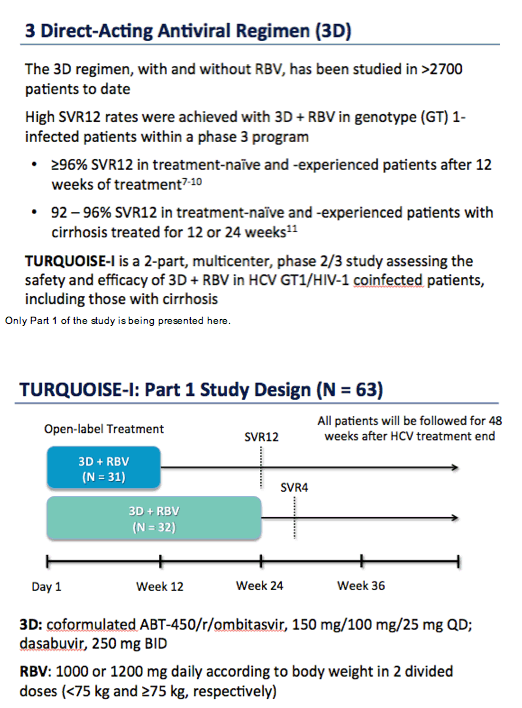
Only Part 1 of the study is being presented here.
1:1 Randomization
Stratification by prior HCV treatment history (treatment-naïve versus treatment-experienced) and presence of cirrhosis (cirrhotic or non-cirrhotic).
Treatment-naïve subjects also stratified by interleukin 28B (IL28B) genotype (CC versus non-CC).
PegIFN/RBV-experienced subjects also stratified by type of previous response to pegIFN/RBV (null responder, partial responder, or relapser).
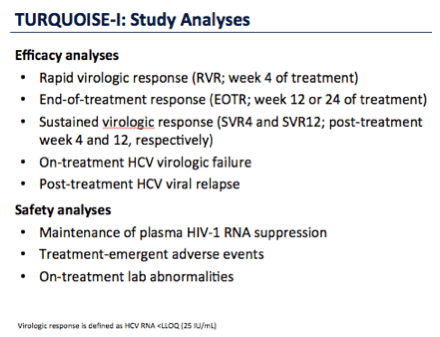
The primary efficacy endpoint is the percentage of subjects achieving SVR12 (HCV RNA < LLOQ 12 weeks after the last actual dose of study drug) within the 12-week treatment and 24-week treatment groups.
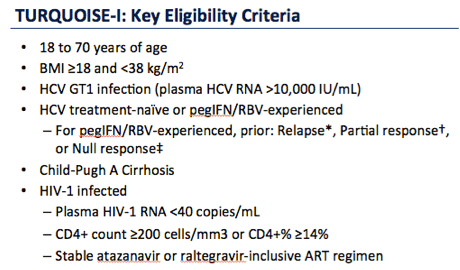
*Relapse: HCV RNA undetectable at or after the end of treatment, but with a detectable level within 52 weeks thereafter
Partial response: >2 log10 IU/mL HCV RNA reduction at treatment week 12 but detectable at end of treatment
Null response: <2 log10 IU/mL or <1 log10IU/mL HCV RNA reduction at treatment week 12 or 4, respectively
Cap on Cirrhotics 30%, Minimum of 10 in Part 1
Child-Pugh B and C cirrhotic patients excluded.
ATV and RAL antiretroviral medications were chosen based on DDI studies in healthy volunteers.
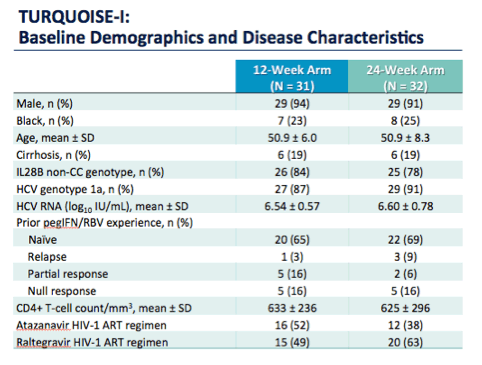
Approximately 20% of subjects in Part 1 had compensated cirrhosis at baseline.
2 subjects in each arm were HCV Treatment-Naïve patients with cirrhosis
3 subjects in each arm were HCV, GT 1a, Prior Null Responder patients with cirrhosis
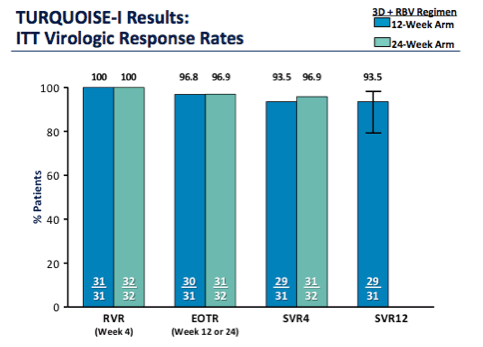
Superiority threshold of 36% for pegIFN/RBV historic control; however, this was not applied as this is an interim analysis
95% CI for 12-week SVR12 is 79.3 to 98.2%.
To date, no subjects in the 24-week treatment arm have experienced post-treatment HCV relapse. 19/20 (95%) have achieved a SVR12 to date.
For the 24-week arm, of the patients with data in the SVR12 window, no patient has experienced relapse.
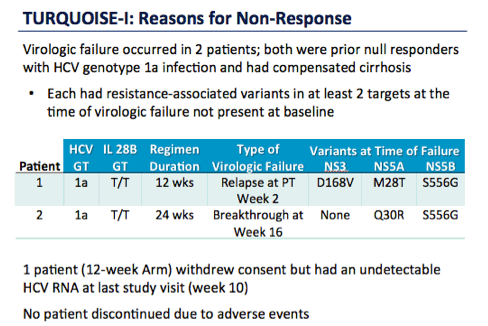
A virologic failure was noted in 1 subject in the 12-week treatment arm (Arm A). This subject experienced a post-treatment HCV relapse at the PTW2 visit (HCV RNA 14,100 IU/mL). This subject was classified as a GT1a-infected, prior null responder to pegIFN/RBV with compensated cirrhosis.
A virologic failure was noted in 1 subject in the 24-week treatment arm (Arm B). This subject experienced HCV rebound during treatment on Study Day 114 (HCV RNA 76 IU/mL). This subject was classified as a GT1a-infected, prior null responder to pegIFN/RBV with compensated cirrhosis.
Both patients with virologic failure were >80% adherent to HCV treatment (Treatment compliance was calculated from accountability data recorded in IRT for each tablet type separately: ABT-450/r/ABT-267, ABT-333, and RBV).
The significance and persistence of these variants is under investigation.
One subject withdrew consent during treatment; this subject's last reported HCV RNA was < lower limit of detection (LLOD) at the Treatment Week (TW) 10 visit.
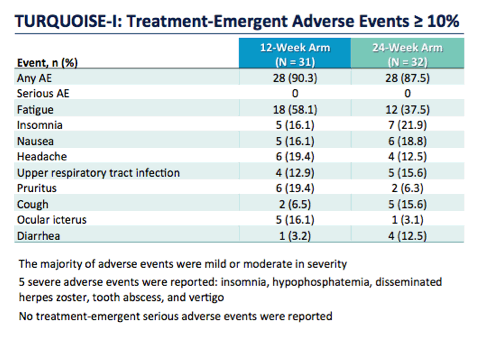
All patients with ocular icterus were on atazanavir ART.
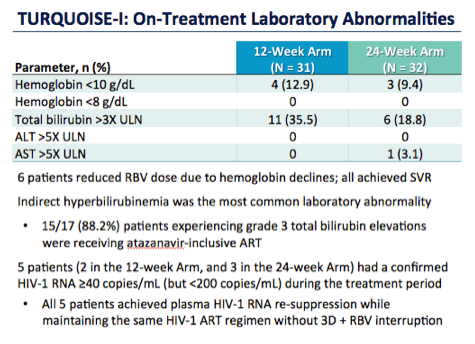
Of the 6 patients who reduced RBV due to decreased Hgb, 4 were in Arm A, 2 were in Arm B
No patient required erythropoietin or transfusion.
An additional 6 subjects (1 in Arm A, 5 in Arm B) reduced RBV dose due to other reasons (insomnia, irritability, weight gain, fatigue, decrease in weight, pruritus, and shortness of breath).
One patient switched ART regimen from ATV to RAL due to hyperbilirubinemia and a mild-intensity adverse event of ocular icterus.
One subject in Arm B experienced an adverse event of rhabdomyolysis in the setting of recently initiating a vigorous physical exercise program. This subject had grade 3 AST and grade 2 ALT elevations concurrent with an elevated total creatine kinase (15,990 U/L) at a single study visit. The subject was treated with hydration and halted his vigorous exercise program. Study treatment was not interrupted and the adverse event resolved after 6 days.
The majority of subjects have maintained plasma HIV-1 RNA suppression.
HIV-1 RNA Assay used: Abbott RealTime HIV-1 Assay which has a LLOQ of 40 copies/mL
2 patients with confirmed HIV-1 RNA ≥40 copies/mL (but <200 copies/mL) during the treatment period in the 12-week Arm: Both on ATV
3 patients with confirmed HIV-1 RNA ≥40 copies/mL (but <200 copies/mL) during the treatment period in the 24-week Arm: 1 ATV, 2 RAL
No subjects in either treatment arm have required a switch of their HIV-1 ART regimen due to loss of plasma HIV-1 RNA suppression.
The rate of low-level HIV-1 viremia is lower than the frequency (27.2%) observed in longitudinal cohort studies such as the HIV Outpatient Study (HOPS).16
Moreover, the rate of low-level HIV viremia may be subject to a detection bias, as the frequency of plasma HIV-1 RNA monitoring in this study is greater than the monitoring frequency for ambulatory HIV-infected patients on stable antiretroviral therapy.
|
| |
|
 |
 |
|
|